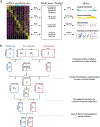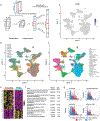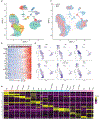Dictionary learning for integrative, multimodal and scalable single-cell analysis
- PMID: 37231261
- PMCID: PMC10928517
- DOI: 10.1038/s41587-023-01767-y
Dictionary learning for integrative, multimodal and scalable single-cell analysis
Abstract
Mapping single-cell sequencing profiles to comprehensive reference datasets provides a powerful alternative to unsupervised analysis. However, most reference datasets are constructed from single-cell RNA-sequencing data and cannot be used to annotate datasets that do not measure gene expression. Here we introduce 'bridge integration', a method to integrate single-cell datasets across modalities using a multiomic dataset as a molecular bridge. Each cell in the multiomic dataset constitutes an element in a 'dictionary', which is used to reconstruct unimodal datasets and transform them into a shared space. Our procedure accurately integrates transcriptomic data with independent single-cell measurements of chromatin accessibility, histone modifications, DNA methylation and protein levels. Moreover, we demonstrate how dictionary learning can be combined with sketching techniques to improve computational scalability and harmonize 8.6 million human immune cell profiles from sequencing and mass cytometry experiments. Our approach, implemented in version 5 of our Seurat toolkit ( http://www.satijalab.org/seurat ), broadens the utility of single-cell reference datasets and facilitates comparisons across diverse molecular modalities.
© 2023. The Author(s), under exclusive licence to Springer Nature America, Inc.
Figures





Comment in
-
Bridging the multi-omics gap.Nat Rev Genet. 2023 Aug;24(8):488. doi: 10.1038/s41576-023-00632-7. Nat Rev Genet. 2023. PMID: 37340169 No abstract available.
References
MeSH terms
Grants and funding
LinkOut - more resources
Full Text Sources
Other Literature Sources

